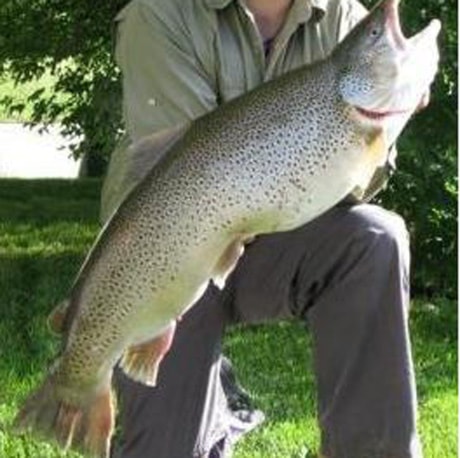Anglers do love to catch something unexpected, and especially if it’s huge. It seems the way to do that this season is to go pike fishing and tie on a Rapala lure.
Early in June, Chris Funk, fishing the main pond at River Bend Golf Course just east of Red Deer for pike, using a Rapala lure (just which model is his secret), took and released a 148 cm sturgeon.
Biologists netted the monster later and estimated it to weigh between 25 and 30 kg, before tagging it and releasing it back to the Red Deer River from which it came in the first place, probably in the June, 2005 “200-year flood.”
Now comes the word that, early in July, Lindsey Paterson, a chiropractor from Pincher Creek, fishing the Waterton River for pike, and using a Rapala lure, took a 21 pound 14 ounce (sportfishing records are kept in Imperial measurements) brown trout that beats the standing Alberta record brown trout by four pounds five ounces.
The previous record brown was taken through the ice at Swan Lake, west of Caroline, on Dec. 15, 1991 by Wesley A. Benson, Sr. of Slave Lake, using a rubber-bodied jig. The record brown previous to that was also out of Swan Lake and, as I recall, was taken near dark in late summer or early fall on a trolled Rapala plug.
Lindsey Paterson’s record brown, though caught in the river, probably gained much of its growth living on the fat of the land in the reservoir behind Waterton Dam, although I have seen browns of considerable proportion in the river in recent years, and outfitters who float the river divulge, under torture, that their clients catch some huge browns.
When my brother-in-law, the late Morgan Johnson, and I were among the few anglers fishing the river years ago, we caught only rainbows, some of them as unlandable as Brahma bulls. The brown trout probably got into the Waterton from its tiny, tangled tributary, Cottonwood Creek, which was stocked with browns in the 60s.
Several columns ago I mentioned good fishing for large triploid rainbow trout in Summit Lake just over the Crowsnest Pass in B.C., and several readers have asked what triploids are. Basically, triploids are “manufactured” with a third chromosome which is created by shocking fertilized eggs with heat, pressure, or chemicals.
The third chromosome causes all females and most males to be sterile. Nutrients and energy usually employed in producing sex organs are instead used for growth, and triploids typically can attain immense and unnatural size and appearance, with tiny heads and tails compared to their obese bodies.
I first saw triploid rainbows in 1987 at a commercial angling operation, Avington, in England. The grotesque brutes reminded me of Sumo wrestlers and swam around the ponds with lure-stuck lips and the bust-off lengths leader material drooping from their mouths like spaghetti.
Now controversy has erupted over the International Game Fish Association having recognized a 48 pound triploid as the new world record rainbow trout. Major objections is that anglers and natural rainbows should not have to compete with manufactured monsters.
The new world record was taken Sept. 5th, 2009, from Lake Diefenbaker, Sask., by Adam Konrad of Saskatoon, and beat out the previous world record, a 43.6 pound triploid taken from
the same lake in 2007 by his twin brother Sean. Adam referred to his triploid as “ugly and fat,” and Sean called his “a freak.”
The two fish result from half a million triploid rainbows escaping from an aquaculture operation on Lake Diefenbaker, and once again remind
us that, despite all assurances from the fish and game farmers, it is not a matter of if the confined creatures will escape into the wild, it’s when.
The triploids were purposely stocked by the B.C. government in Summit Lake to provide anglers with a “trophy” fishing opportunity. They are being increasingly stocked in the western U.S. to provide “additional angling opportunities,” without endangering wild, native trout populations through cross-breeding.
Stocking triploids in itself has become controversial for several good reasons, all having to do with harming the wild, natural species. A few of the fertile males can spawn with wild, natural females, thus polluting the wild native gene pool. The immune systems of triploids are now known to be defective, thus they can become incubators and spreaders of diseases to the wild, natural fish populations.
Then there is the simple question of competition for food and space. It has long been known that stocking normal hatchery trout on top of a resident population harms the resident population. Imagine how much harm is done by huge, ugly brutes eating everyone out of house and home just to maintain and gain weight.
Yes, anglers do love big surprises at the end of their line, but should probably boycott fishing for stocked “surprises,” laboratory freaks that are harmful to wild, natural trout populations.
Bob Scammell is an award-winning outdoors writer living in Red Deer.
